Civilian employment falls to 1.3% below prior peak.
DWD released employment statistics today (usually it’s two or three days before the BLS release, but this time it’s just a day early).
First, note that for both nonfarm payroll employment and private nonfarm payroll employment, June figures were revised downward.
Figure 1: Wisconsin nonfarm payroll employment from March release (blue), April release (red), May release (green), June release (black), and July (teal). Source: BLS, and DWD.
Figure 2: Wisconsin private nonfarm payroll employment from March release (blue), April release (red), May release (green), June release (black), and July (teal). Source: BLS, and DWD.
An apt characterization of the situation is that establishment survey based estimated employment is treading water. However, that’s not the entire story; the household survey (which is typically less accurate than the establishment) indicates continued downward movement in civilian employment. The two surveys taken together indicate some worrisome trends are in place.
Figure 3: Wisconsin nonfarm payroll employment (blue), and civilian employment (red), s.a., in 1000’s. NBER defined recession dates shaded gray. Dashed line at beginning of Walker Administration. Source: BLS, DWD, and NBER.
While the unemployment rate remained constant (keeping in mind unemployment rate is the ratio of two variables, including labor force, which decreased 7,500).
Figure 4: Wisconsin-US unemployment rate differential (blue), average over 1986-2010 period (red) and plus/minus 2 standard error bands (estimated using HAC SEs from regression of differential on constant). Source: BLS, DWD, and author’s calculations.
In addition, the Wisconsin unemployment rate is now rising relative to US, and is now borderline statistically significantly above the 1986-2010 average differential. In other words, while Wisconsin’s unemployment rate is lower than the US, it is on average lower than the US rate. And right now, the gap is smaller than it usually is.
Highlights of QCEW figures were released yesterday. I’ll try to update my estimates of implied nonfarm payroll employment when those numbers are finally posted. My previous estimates suggested a downward revision of over 10,000 for December 2014.
Update, 7:50pm: Lagging economic growth seems to have had some impact on the Governor’s job performance ratings.
Source: Marquette Poll: Scott Walker’s approval level at home drops below 40 percent.
Update, midnight Pacific
Using the methodology outlined in this post, I pseudo-benchmark Wisconsin private NFP:
Figure 5: Wisconsin private nonfarm payroll employment (blue), and predicted (red). Light blue shading denotes data used for regression. Source: DWD and author’s calculations.
This implies that the WI private NFP number for March 2015 will be around 2463, which compares to the currently reported value of 2471.
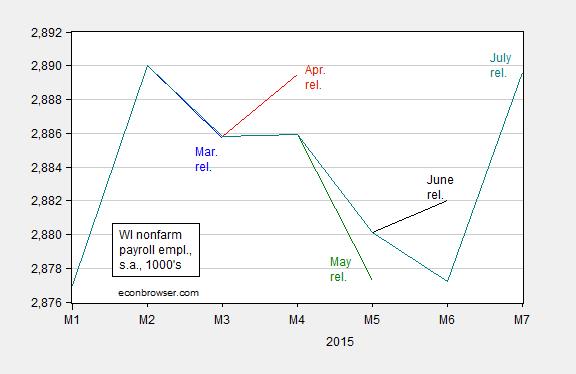
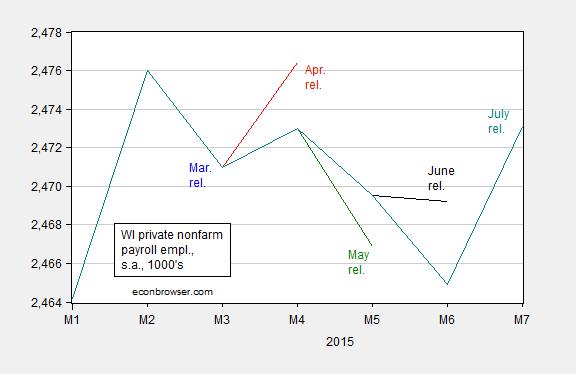
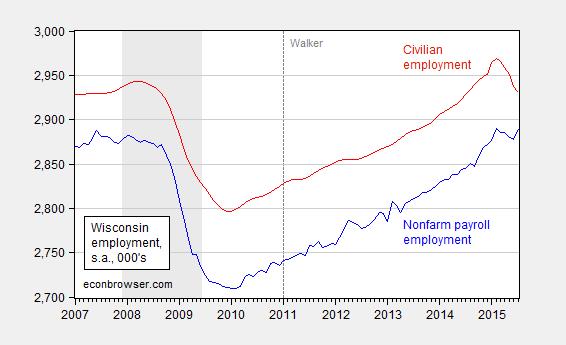

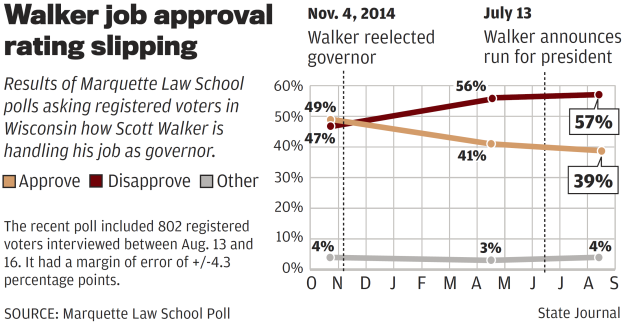
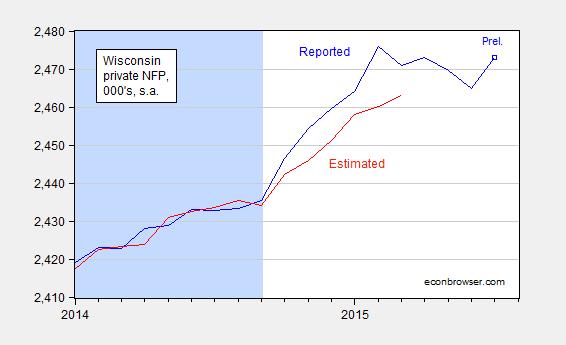
So Wisconsin is essentially a reflection of the average state?
“the number of full-time jobs today is 0.7%, or 822,000, lower than it was at the prerecession peak—and that was eight years ago. What we have seen within these numbers is a dramatic and unexpected increase in part-time jobs.”
http://www.wsj.com/articles/who-will-get-the-dreary-economy-going-1440112915
I wonder why companies are hiring more people as part time employees now. I wonder if any major regulation was passed in the last 8 years that incentivized them to do so. I’ll have to do some research.
Anonymous: “I wonder why companies are hiring more people as part time employees now. I wonder if any major regulation was passed in the last 8 years that incentivized them to do so. I’ll have to do some research.”
Ah, yes, another example of fact-free conservatism. Don’t strain yourself. The research as already been done. Three independent studies have recently confirmed that there as been no significant increase in part time work as a result of the Affordable Care act, in contrast to predictions of conservatives. One is from the ADP, the country’s largest payroll service company, another is from the Urban Institute, and the third is from the communists at !George Mason and the American Enterprise Institute!
You would think that conservatives would lose credibility as all of their ACA predictions fell flat: millions would lose their insurance, premiums would skyrocket, and employers would shift to part time workers. However facts have never been a conservative strong point because facts have a well-known liberal bias.
Joseph,
Then why the increase in part-time?
Maybe if you knew how to do economic analysis you would know that part time employment has been growing less than total employment–a perfactly normal cyclical development.
I challenge you to find a non-recession year when part time employment did not grow.
Spencer:
Well said.
Link to the AEI study? If they said that I’ll eat my words.
But the rest of the point still stands. It’s not like the country is taking off and Wisconsin is falling behind. Menzie is just trying to destroy Walker’s credibility; I don’t know why he bothers because Walker isn’t going to be the GOP nom.
Anonymous aka Scott Walker, American Patriot and Freedom Fighter: I think the reference is to this paper. I look forward to seeing you undertaking the promised action.
Actually, if you’d looked at a number of posts, you will see (1) Wisconsin is lagging behind the US in terms of employment (measured either way) and economic activity, and (2) lagging behind what is expected based on historical correlations.
I keep on writing about Wisconsin and Governor Walker because (1) the policies have an impact on my state, and (2) the policies undertaken here have been proposed for other states.
Menzie,
There has to be other names I’ve posted under, but that certainly was a good one. Here is another one you can add to your spreadsheet tracker.
The paper you linked attempts to examine how forward looking firms were and examined payroll data from 2008 to mid 2014. Since the mandate didn’t go into effect until this year, this paper or another should really update data to include this year and subsequent years data in the future to really determine if the ACA is encouraging more part time jobs. But ceteris paribus, if you make employees more expensive at 30+ hours a week compared to fewer than 30 hours, there is no question that it does. I’m not sure how that is even debatable.
I’m glad I didn’t have to eat crow, but I maintain I will if AEI puts out a study showing the ACA didn’t increase part time jobs.
Future President Donald Trump aka Anonymous aka Scott Walker, American Patriot and Freedom Fighter: Your other monikers were BUT THE MODELS SHOW US!! aka (xo poa) aka YOLO! aka JS aka Joe. I don’t need a spreadsheet. As long you insist on posting from work, the system knows who you are.
I’m not trying to trick anyone. Your comments don’t require a registered name, so most of them time I just don’t bother putting one in. Other times I put in a moniker for the lolz.
It’s easier to comment on a keyboard than a phone, that’s why I INSIST on posting from my work computer. I’m sure I shouldn’t per company policy, and since you seem to want to punish me for disagreeing with you by telling people where I work, I should probably stop doing that or just stop visiting your blog altogether.
Future President Donald Trump aka Anonymous aka Scott Walker, American Patriot and Freedom Fighter aka BUT THE MODELS SHOW US!! aka (xo poa) aka YOLO! aka JS aka Joe: I didn’t say you were trying to trick anyone; I just like people to know who is associated with given comments as a whole. For instance, you’re a Scott Walker supporter, a disbeliever in anthropogenic climate change, a believer that ACA will have a measurable impact on part-time/full-time work ratio, and who wrote:
I am happy for you to write in from your work computer. All I’m saying is that I don’t need to keep a spreadsheet because your IP address is clearly identifiable. Please keep on posting from work — more traffic the better.
Let me add, you’re in no danger — I didn’t identify your workplace in this thread.
Anonymous: “Link to the AEI study? If they said that I’ll eat my words.”
Thank you for illustrating my point about fact-less conservative faith. You can’t even conceive the possibility that an AEI paper would dare to contradict conservative dogma no matter the facts of the case. To tell the truth, I’m a little surprised myself, given their publishing history.
Thank you, Menzie Chinn, for providing the link I neglected.
Ricardo: “Then why the increase in part-time?”
The short answer is that there simply isn’t a significant increase in the amount of part time work. Nothing like the predictions of ACA opponents.
The longer answer is that there has been a sharp increase in the amount of voluntary part time work and a sharp decrease in involuntary part time work. This result is exactly as predicted by the CBO in their ACA cost analysis back in 2010. This result is exactly contrary to the predictions of conservatives.
As the CBO predicted, more people would voluntarily choose to work part-time to spend more time caring for their children once the ACA freed them from the necessity of full time employment for health insurance. On the other hand, there is no evidence of employers increasing the amount of involuntary part time work to avoid paying for health insurance. In fact, it is just the opposite. Employers are increasing hours worked as the economy improves.
The increased ability to spend more time raising their children rather than at low productivity jobs is a big win for middle and lower class Americans and a big win for the welfare of the country.
http://www.cepr.net/blogs/cepr-blog/the-aca-and-part-time-work
That is absolutely an absurd post. Listen to what you are saying: “The ACA freed them from having to work full time to get health insurance.”
I’ll read your link but that is just preposterous.
I read your article. Seems far more likely that is is boomers retiring and taking in part time jobs for extra cash.
The ACA doesn’t make it so one can raise their children on part-time income.
the aca was never meant to allow people to raise their own children on part time income. but it did help to break the link between reasonable cost/benefit health insurance and the workplace. prior to the aca it was rather difficult in many places to obtain quality health insurance through anything other than employment. the aca broke up that model. you think you could buy affordable, family wide health insurance through a broker a decade ago? i know many people who worked lousy jobs not because of the pay, but because it gave them access to health insurance for their family. that insurance was not affordable in the marketplace, mostly due to risk premium differences.
Anonymous: “That is absolutely an absurd post. Listen to what you are saying: “The ACA freed them from having to work full time to get health insurance.”
Hiatus! ShadowStats! ZeroHedge! What is with conservatives and data? Is everything a conspiracy?
There is nothing surprising in the part-time employment numbers. The CBO predicted what would happen and that’s what happened. How is that absurd?
The CBO said that a certain percentage of people with low paying jobs would voluntarily convert to part time jobs as a result of the ACA. These are people who have terrible jobs which barely pay, would rather spend more time with their families, but remained full time because that was the only way they could get health insurance — for example spouses whose wages barely cover child care costs. The number of voluntary part time workers has increased as expected since they no longer are required to work full time if they don’t want to.
The CBO also said that a small number of employers would cut employee hours to avoid the cost of health insurance, and the data shows that number to be insignificantly small. Conservatives predicted the opposite, that involuntary part time work would soar, that the ACA would be a “job killer”. They were wrong — again.
You’re speculating what is causing the changes in the data and then saying the data proves your speculation.
People with low paying jobs didn’t go part time because of the ACA. You’re seriously delusional.
Anonymous, I don’t know what else to tell you. The data is the data. The CBO made a prediction of the effects of the ACA and that prediction was subsequently borne out by the data. That’s as close to a scientific method as you are going to find in economics.
The BLS counts the number of part time workers and separates them into two groups — voluntary part time and involuntary part time. The voluntary part time are those who state that they are not seeking and do not want full time work. The involuntary part time are those who say they are currently working part time, want full time work but can’t find it.
The prediction of ACA opponents was that the number of involuntary part time workers would increase as employers cut back their hours to avoid paying for health insurance. Their prediction turned out to be false, as indicated by the data. The ACA was not a “job killer”.
The prediction of the Congressional Budget Office was that the number of voluntary part time workers would increase because some low wage workers would no longer need to work full time just to get health insurance. This prediction turned out to be true, as indicated by the data.
And we are still waiting for you to fulfill your promise — “Link to the AEI study? If they said that I’ll eat my words.”
Are you low IQ? The AEI study didn’t say what you said it did. Read above.
Anonymous, the AEI paper says: “Thus, we conclude that the observed shift across hours categories is unlikely to have been caused by the ACA’s passage. We speculate that if employers did not shift workers slightly above the 30-hour threshold to slightly below the threshold, they are unlikely to have shifted workers from 40+-weekly hours to below the 30-hour threshold.”
Your original premise was that employers were shifting workers from full time to part time because of the ACA. The AEI study found no evidence for this.
You know, when even the right-wing AEI says that your right-wing belief is wrong, you just might be wrong.
The looked at data before the mandate went into effect. Did you even read it?
Here is what the AEI paper said: “Although the employer mandate only went into effect in 2015, many observers have argued that forward-looking employers began to shift towards a part-time workforce well in advance of the mandate.”
The AEI found that prediction by conservatives to be false.
But the data doesn’t stop there. The BLS has data right up to the present. It shows that the number of involuntary part time workers has been declining since the passage of the ACA in 2010 and has continued to decline after the mandate went into effect in January. According to ACA opponents, part time work should have increased in the lead up to the mandate and then increased sharply in the first year of the mandate. The data shows that just isn’t happening.
http://data.bls.gov/timeseries/LNS12032194
I know it is hard for conservatives to face the truth but all of their dire predictions about the ACA have fallen flat.